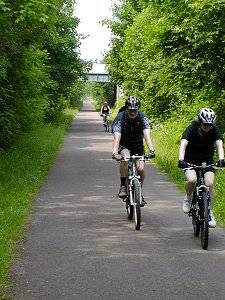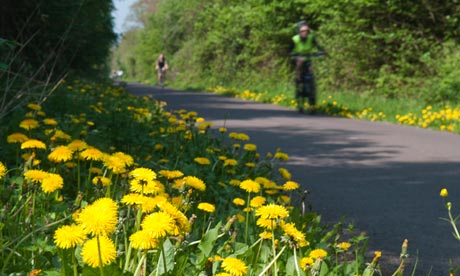
Bath resident and cyclist Paul Stephens has created a virtual journey of the Path on his own website, Paul's Pages.
The Bath - Bristol Cycle Path at www.paulspages.co.uk
The Bristol and Bath Railway Path is a 15-mile (24 km) off-road cycleway, part of National Cycle NetworkNational Cycle Route 4. It has a 3-metre (9.8 ft) wide tarmacked surface, and was used for 2.4 million trips in 2007, increasing by 10% per year.[1]
Bristol and Bath Railway Path - Wikipedia, the free encyclopedia
The Bristol Bath Railway Path
The Bristol to Bath Railway Path provides a tranquil walking and cycling path between the two cities... This was Sustrans flagship walking and cycling path completed in the mid 80s and largely constructed through a youth employment scheme and many volunteers.
Bristol's Railway Path is becoming a victim of
its own success
Building more quality safe space for
cyclists along main routes will prevent them all crowding onto one path

Bristol Railway Path is the oldest 15 miles of the
National Cycle Network. Photograph: Joe Dunckley
"If you build it they will come" has not
always been true of the great British cycling facility. The
bafflingly inappropriate pavements, muddy tracks and steps are usually no more
attractive than riding on busy roads with fast cars and big trucks.
But the oldest 15 miles of the National Cycle Network prove that if
you build it to a sufficient quality they really will come, and they will
passionately defend it when it is under attack. The Bristol and Bath path,
built in the 1980s on a disused railway between the neighbouring West Country
cities, is a rare example of a truly successful British cycle route –
sometimes, as in Copenhagen, too successful. Recently
upgraded with Bristol's "Cycling City" money, the success of the path
can be seen on any weekday morning, even deep in November.
Steve Loughran, a
campaigner in Bristol, explains why the path makes such a good cycle route:
"It's direct and
sustained from the edge of the city right into the centre at Temple Meads
station, never abandoning you at difficult junctions or unfamiliar streets.
It's in cuttings and embankments so you aren't interrupted by busy crossroads,
and there aren't any trucks passing too close or parked cars blocking your
lane."
The Railway Path would not meet modern Dutch cycle path standards, with a mere three
metre-wide asphalt surface, and with people on foot and on bicycles sharing
that limited space. Even so, in terms of getting people on their bikes, it has
worked where promoting riding in urban traffic has not: Sustrans says that this
summer the path carried 3,000 cycle journeys per day and even more journeys on
foot, with usage growing by 10% every year.
While cycling on
Britain's roads is now largely limited to commuter transport – and
disproportionately for the young adult male – the Railway Path attracts a
healthy mix of users and uses – commuters, shoppers, and parents and children
on the school run.
But I think the
solution to the Railway Path's overpopularity lies away from the path itself.
Its directness, continuity and calm are a great pull, but there is also the
powerful push of dangerous and uncomfortable roads. It was built and they came;
build more quality safe space for cycling, on all the main routes, and perhaps
then they won't all come to this one place.
• Joe Dunckley is a freelance
writer and supporter of the Cycling Embassy of Great Britain
.
.
.

No comments:
Post a Comment